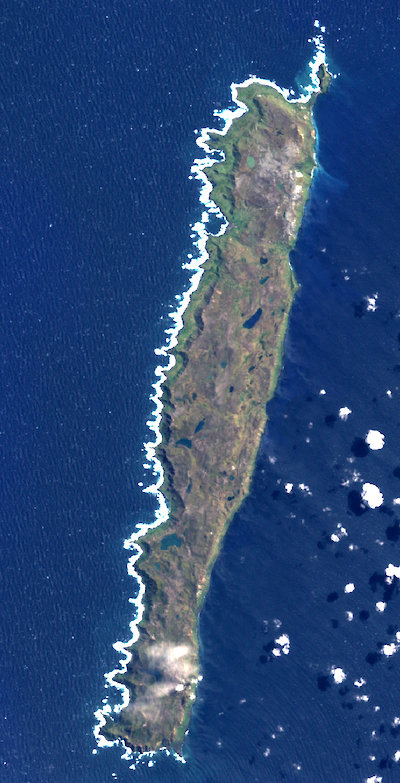A soggy green sponge
Macquarie Island is about 34 kilometres long and around five kilometres wide. Most of its 128 square kilometres is a plateau above 100 metres, with its highest point 433-metre Mount Hamilton, named after the AAE biologist on the island, Harold Hamilton. Besides numerous tiny islets, the main offshore islands are Judge and Clerk Islands, 16 kilometres to the north, and Bishop and Clerk Islands, 29 kilometres south.
‘The soggy green sponge’ is a well-used description of the island. It rains six days out of seven –the island’s flat top is a myriad of lakes, ponds and peat-bogs — and relative humidity is typically around 90 percent. It is also windy, with a mean wind speed of 30 km/h. Its temperature is one of the world’s most equable, with small yearly, seasonal and daily temperature variations (mean daily maximum temperatures range between 8.8°C in January and 4.9°C in July). It has no permanent snow or ice cover.
The island’s most recognised quality is its rich and diverse animal life. Since 1977 Macquarie Island has been a Biosphere Reserve and has been listed on the National Heritage Register. Macquarie Island Marine Park, proclaimed in 1999, is the second largest marine protected area in the world. Since 2000 the island’s protected waters have extended for a radius of over 370 kilometres from the island’s coast.
Around 3.5 million seabirds breed and moult there, mostly penguins. Of the four species, the endemic royal penguin is most numerous at around 850,000. Others are the king, gentoo and rockhopper.
Macquarie has around 2000 breeding pairs of its most abundant albatross species, the light-mantled sooty. The black-browed and grey-headed each number around 100 pairs. There are less than 10 breeding pairs of the world’s biggest flying bird, the wandering albatross.
Of the four breeding seal species, three are fur seals (Antarctic, sub-Antarctic and New Zealand). About a seventh of the world’s elephant seals make their home on the island.
The island has 46 currently-recorded species of vascular plants, more than 80 species of mosses, over 50 hepatics, over 100 lichens and over 100 species of marine and freshwater algae. It is too cold for woody plants (trees and shrub). The main vegetation types are tussock grassland, mire and feldmark.

